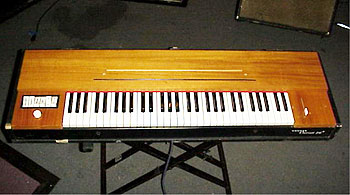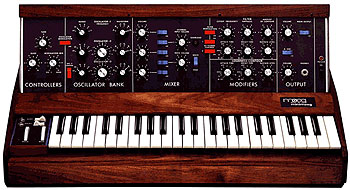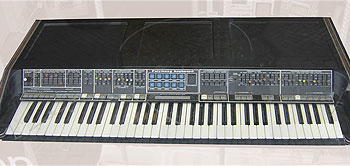Way Out Sounds: Roger Joseph Manning, Jr. and Synths That Defined The Seventies
Published on December 5th, 2011 in: Dancing Ourselves Into The Tomb, Issues, Music |By Ayan Farah
Multi-instrumentalist, singer, and songwriter Roger Joseph Manning Jr. is renowned for the melody-rich, intricately arranged compositions his fans have latched onto throughout his nearly 25-year musical career. In each of his diverse band projects (Jellyfish, Imperial Drag, The Moog Cookbook, TV Eyes, Malibu), his ongoing collaborations with Beck, as well as his stellar solo efforts (2006’s The Land of Pure Imagination and 2008’s Catnip Dynamite), what remains constant is Manning’s unshakable ability to create very complex yet highly enjoyable music that is punctuated by his keyboard wizardry.

His indelible mark in the world of keyboards is embodied by his innovative use of vintage analog synthesizers, while his vast collection of those instruments over the years has cultivated a greater proficiency, intimacy, and almost encyclopedic knowledge of his primary instrument of choice. ” I did a lot of treasure hunting”, explains Manning. “I spent a lot of time in the early Nineties looking for stuff. I was quite the addict for those antique keyboards.”
Roger has made guest appearances on countless records, offering his songwriting, production, and keyboard playing skills to artists of various musical genres and is always on the lookout for new and emerging talents with whom he can collaborate. He has most recently appeared on Glen Campbell’s Ghost on the Canvas where he composed the incidental music between the album’s songs. He is currently working with Harper James Simon (Son of Paul Simon) and likens Simon’s upcoming debut album to “the best of Elvis Costello and The Smiths.”
Here, Roger discusses his favorite synthesizers of the 1970s, an era in music that he often heralds as a source of inspiration for his career. He also identifies the albums that best showcase the sonic prowess of each of those synthesizers, citing prominent musicians that have pushed the boundaries of modular sound.

The Clavinet
Although it’s not a synthesizer per se, it is an instrument that was designed to imitate a harpsichord. It’s an electronic instrument that became this whole other entity and was used a lot in the ’70s, not only in a lot of the classic, funk recordings made famous by Stevie Wonder, but I particularly enjoy when the clavinet was used in a more rock and roll context. One of my favorite records—actually it’s one of my favorite keyboard records—is the Rolling Stones’ Goat’s Head Soup (1973). Billy Preston is the main keyboard player on that record and he primarily plays the clavinet and the RMI Roxichord electric piano (also used extensively by Ron Mael of Sparks, namely in the single “This Town Ain’t Big Enough for the Both of Us,” from 1974’s Kimono My House). But he uses them in such a way that he actually becomes almost the third guitar player. That album was very influential and inspiring to me.

The Mighty Moogs: Moog Modular, Minimoog, and Polymoog
There have been very few models that the Moog Company has made that weren’t useful in some way or another but I definitely had favorites over the years. I’m definitely a fan of the Moog filter sound, which has a very distinct sound. The best-sounding versions they’ve ever made, in my opinion, are the vintage modular systems (1965-1972). Unfortunately, they were so expensive that very few people could ever own them. I’ve never owned any myself but I’ve had the privilege to be able to play and record using them. But they are just notably the most brilliant sounding and just the most . . . extreme. Some of the recordings that showcase the sonic abilities of the Moog synthesizers are Wendy Carlos’s A Clockwork Orange soundtrack as well as the recordings that Dick Hyman did where he took a lot of popular songs and turned them into funky, rock and roll synthesizer arrangements. And there are lots and lots of incredible soundtracks and musique concrète stuff, where the Moog Modular has been used.
But for a lot of my friends and I, the Minimoog (1970) was certainly a workhorse, one that was used quite frequently because it was very simple and straightforward but you could get a lot of mileage out of it. I’m a big fan of a lot of the recordings that Rick Wakeman did with the band Yes in the early ’70s, particularly on the albums Fragile (1971) and Closer to the Edge (1972).
And on the other side of that, you had a guy like Jan Hammer who made tremendous contributions to the fusion rock/jazz world as a keyboardist with Mahavishnu Orchestra and certainly on his own. His whole objective was to get the Minimoog to compete sonically and have a presence equal to that of the electric guitar, which I really think he achieved not only sonically, but with his note choices. So, those were very influential artists and the Minimoog was definitely a part of my palette when I could finally get my hands on one, which wasn’t until long after college. When they became not very sought after, second-hand instruments I was able to finally afford some.

The Polymoog (1976) is fantastic! Gary Numan relied heavily on the Polymoog for his solo albums and his work with Tubeway Army to create the sounds that made his music so distinctive. The Pleasure Principle, (1979) which includes the hit song “Cars,” is like a demonstration record for the Polymoog and he uses it on almost every song on the album. He really pushed that synth to the limit. He used sounds that were very out of tune, very wobbly, to create that space-age, futuristic atmosphere for his music which I find very inviting. It’s a very seductive sound and I am very much a fan of it!
Pages: 1 2
One Response to “Way Out Sounds: Roger Joseph Manning, Jr. and Synths That Defined The Seventies”
December 6th, 2011 at 4:44 pm
Wonderful article!
Time limit is exhausted. Please reload the CAPTCHA.